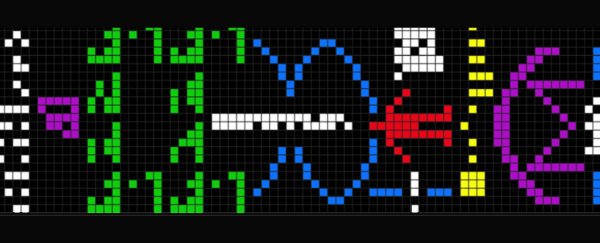If you're an alien far, far away inside the globular star cluster M13, one day you might receive a radio message from Earth written in binary code.
Decoding it would give you a beautiful 8-bit style picture of some basic human information – including the structure of DNA, a graphic of our Solar System and a picture of a man (minus his head).
44 years after the Arecibo Observatory in Puerto Rico broadcast that message, the team at Arecibo are hoping to inspire young kids and young adults to create a New Arecibo Message for the next generation.
"Our society and our technology have changed a lot since 1974," says Francisco Cordova, the director of the NSF-funded Arecibo Observatory.
"So, if we were assembling our message today, what would it say? What would it look like? What one would need to learn to be able to design the right updated message from the earthlings?"
"Those are the questions we are posing to young people around the world through the New Arecibo Message," he added.
The process won't be a simple one though, the researchers explain; teams of up to 10 students (from kindergarten through to college) will have to decode clues and learn about space science in the process.
After completing a series of projects, the winners will be announced during Arecibo Observatory week in 2019.
The history of the original Arecibo message is pretty amazing. The radio message was approximately three minutes long and was exactly 1,679 binary digits (picked because it is a semiprime number).
It was aimed at the M13 cluster of stars a casual 25,000 light-years away from Earth. So it'll be a little while before we know if it's arrived or we end up with a response.
At the time, it was known as a bit of a publicity stunt to show off the 1,000 foot (305 metre) diameter Arecibo dish, which was the largest and most powerful at that time.
That being said, it reportedly brought some people that were there to actual tears.
"It was strictly a symbolic event, to show that we could do it," said Donald Campbell, Cornell University professor of astronomy, who was a research associate at the Arecibo Observatory at the time explained in a blog post on a recent Google Doodle commemorating the event.
A team of researchers from Cornell University, with assistance from Carl Sagan himself, crafted a message to show our way of counting (decimal), the atomic numbers of the elements that make up DNA.
It then goes on to explain the formulas for the sugars and bases in DNA, as well as a graphic of the DNA helix structure, the population of Earth at the time, and the average height of a man.
Finally it shows our place in the Solar System, and a graphic of the Arecibo telescope.
We don't know what this New Arecibo message will look like, or even if the winning response will one day be sent to the stars as well - but it sounds like a great way to get the next generation excited about the wonderful Universe beyond our home planet.
If you want to find out more, you can check out the Arecibo Observatory website here.
